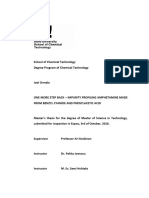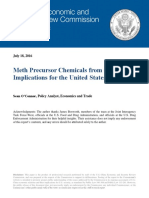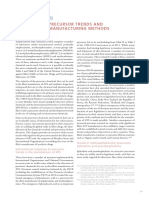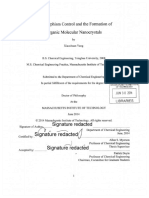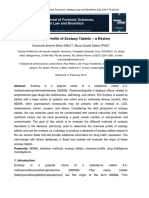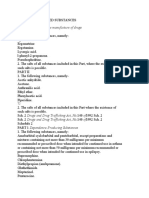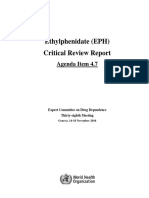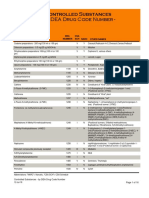0 ratings0% found this document useful (0 votes)
167 views7 pagesComplete Synthesis of Cocaine by Naviori Method
Complete synthesis of cocaine by Naviori method
Uploaded by
elahemohajer06Copyright
© © All Rights Reserved
We take content rights seriously. If you suspect this is your content, claim it here.
Available Formats
Download as PDF or read online on Scribd
0 ratings0% found this document useful (0 votes)
167 views7 pagesComplete Synthesis of Cocaine by Naviori Method
Complete synthesis of cocaine by Naviori method
Uploaded by
elahemohajer06Copyright
© © All Rights Reserved
We take content rights seriously. If you suspect this is your content, claim it here.
Available Formats
Download as PDF or read online on Scribd
You are on page 1/ 7
"
eee
Si ven
Sioeom
cs
Gas
‘Armonia odor pretnt at aus
‘very ow ove. Seo Said
‘lo inarta, coroatvos,
‘SOURCE: Oregon Department of Human Resources 1988
468
NOTICE: THI
BY CoPyRigy
IS MATERIAL MAY
ff
$88
eyes,
eyes,
yee
HT LAW (TITLE 47,
5 PAOTecTED
US. Cope|
Heavy Metal and Organic
Contaminants Associated With Iicit
Methamphetamine Production
Brent T. Burton
INTRODUCTION
Methamphetamine isa power stimulant drug commonly known an the street
‘as ‘crank’ or “speed.” It is currently the most popular and widespread
amphetamine that's Wegally manufactured, distributed, and abused.
Itt methamphetamine 's produced n clandestine laboratories that
‘widespread in the United States. The profit motive forthe clandestine chemist
is enormous, with some laboratories producing In excess of $300,000 per week
In street value. Although several other lic drugs of abuse are occasionally
‘manufactured in clandestine leboratories, methamphetamine accounts for
almost 95 percent ofall clandestine laboratory selzures. The frequency of
laboratory seizures has been increasing nationwide over the past decade (Anon
1988). The States of California, Texas, Oregon, and Washington have shown
the greatest incroase in clandestine laboratory activity.
‘Adverse health effects to the sbusor are not limited to toxic effects of the drug.
iit drugs produced In clandestine laboratories by unskilled chemists are lkaly
to contain potentially toxic contaminants due to unintended reaction by-products
‘and reagent residuals. Process errors In the production of clandestine dru
previously have resulted in severe health effects, including acute Parkinson's
disease from attempted production of 1-methy!-4-phenyi-4-proplonaxy-
piperidine (MPPP) and acute lead poisoning from injection of methamphetamine
(Alcott et al. 1987; Ballard et al. 1985; Norton etal. 1989).
‘The average concentration of methamphetamine street samples is
‘approximately 40 to 50 percent (Hall etal. 1988). Most contaminants found in
lett drugs are Intentionally added by the distributor to dilute or “cut” the product,
to Increase profits. Such substances include lactose, mannitol, idocaine,
procaine, caffeine, quinine, and sodium bicarbonate and may account for as
47
‘much as 94 percent ofthe fnished produet (Grinspoon and Bakalar 1985). In
the case of drugs produced by the clandestine chemist, additonal contaminants
‘may be Introduced by the production process. One can predict such potential
Contaminants due to unreacted substances or unintended reaction products,
{rom known production methods available to the clandestine chemist. Though
‘unintended contaminants may be Introduced into the fished drug by the
Clandestine chemist, the extent and types of substances as a result of the
Production process have not yet been adequately studied.
HISTORY
Methamphetamine was developed in 1919 as an amphetamine derivative by A.
Ogeta, a Japanese pharmacologist. However, it was not until the 1930s that
the pharmacciogic properties of amphetamines became known. The
‘sympathomimetic properties of amphetamines initialy made them useful as
vasoconstrictor agents, and they ware frst introduced into the marketplace In
1932 as Benzodrino, an inhaler designed for celle of nasal congestion, Users
‘of these nonprescription inhalers soon noted that the ammohetarmine contents
‘Were powerful central nervous system stimulants. This property subsequently
‘made amphetamines useful drugs In the treatment of narcolepsy and some
forms of depression but also made them desirable as drugs of abuse,
‘The abuse of amphetamine began almost as soon as it was avaliable as an
‘over-the-counter medication, Shortly after the Benzodrine nasal inhaler
became available in 1931, abusers wore taking apart the spray botte to retrieve
‘the paper inside containing 250 mg of amphetamine. These strips of paper
then were consumed in chewing gum or stirred into a beverage for ts
‘stimulating and euphoric effect (Grinspoon and Hedblom 1975).
‘By 1962 the legal production of amphetamines was estimated by the Food and
Drug Administration to be more than 8 billon tablets per year, with output
Increasing every year. Much of the amphetamine abuse of the 1950s and
1960s occurred as a result of prescription abuse by individual patients obtaining
‘drugs from thelr private physician, many of whom knowingly were writing
Prescriptions for proft.
‘The drug culture of the 19608 braught a dangerous new route of administration
for amphetamines. An injectable form of pharmaceutical methamphetamine
rapidly became responsible forthe amphetamine sbuse ifestyle known as the
“speed freak.” The dangerously addictive nature of injectabie emphetamines
became obvious with the advent of the amphetamine-tolerant freak whe would
Inject as much as 15 g of amphetamine during a single day (Grinspoon and
Hedbiom 1978).
\Untl the 19708 most amphetamines were obtained from pharmaceutical
sources that were divarted into the black market. It has been estimated that as
‘much as 60 percent of leghimate amphetamine production was diverted by
shipments to unauthorized persons, thefts, or prescription forgeries (Morgan
1981).
Due to the abuse of amphetamines and othor drugs in the United States,
‘the Controlled Substance Act (CSA) was passed in 1970, which designated
control schedules for drugs according to their abuse potential. This act
dramatically changed the availablity of pharmaceutical amphetamines by
requiring special procedures for manufacturers to register shipments and
provide detailed accounting of transactions involving controlled substances.
Predictions that strict controls wuld result ina shift to clandestine production
‘of methamphetamine did not materialize at that time. However, the increased
avalabllty and use of cocaine in tha 1970s may have temporarily reduced
market demand for methamphetamine.
‘As amphetamines became more dificult to obtain, purty of street samples
began 10 decline. During the mid-1870s many street samples sold 38
amphetamine contained litle or none of t, and a varity of drugs began to show
tp thet were being sold as amphetamine. Samples of street amphetamines in
41973, after the effect of the CSA was apparent, contained only about 10 percent
amphetamine on average (Morgan 1981). Most often, over-the-counter drugs
‘with stimulant proparties such as caffeine, ephecrine, and phenylpropanolamino
‘ware substituted and sold as amphetamine. This practice eventually led to the
drug look-alike” business, a thriving mail-order enterprise offering these legal
‘over-the-counter drugs packaged and promoted with names, tablet shapes, and
Colors designed to mimic amphetamines.
‘Since the mid-1980s there has been a reemergence of the ilicit use of
‘methamphetamine, One such Indicator isthe rapid increases that have been
documented in numbers of clandestine laboratories seized by law enforcement
agencies. Most recently, media reports have focused on the Increasing
Popularly of “ce,” a smokable form of methamphetamine (Lerner 1989). The
se ofthis crystalline form of methamphetamine has been prevalent especially
In Hawall, where its Imported from Paci rim countries. As this form of
methamphetamine becomes more widely avalable in the United Statos, itis
possible that stimulant users once again wil shit to methamphetamine.
CLANDESTINE SYNTHESIS OF METHAMPHETAMINE,
Ilict manufacture of methamphetamine is a simple process that does not
require special knowledge or expertise In chemistry. Most methamphetamine is
49
‘produced by relatively uneducated persons who synthesize the drug trom
published or harwritian recipes. The drug subcutue provides abundant
‘opportunities forthe potential clandestine chemist o obtain recipes, or ever
lation cooking lasses, for methamphetamine. Many recipes in cicultion aro”
hhandwriten Instructions thet describe how to procure the needed chemicals,
‘lassware, and supplies. Those instructions often include detalled sketches
{and descitions of the procedure 20 the novice can produce methamphetamin
‘without prior traning. Some underground recipes even describe the legal status
of various chemicals and methods to avoid detection by law enforcement
offal
Several publications, avalable in bookstores or by mall arder, describe the
‘methods of drug manufacture. One such publication, Psychedelic Chemistry,
‘describes detaled recipes forthe production of several drugs. in addition,
Information is provided about how to obtain chemicals and laboratory equipment
Without prompting the attention of law enforcement officials (Smith 1981).
The clandestine chemist need not resort to handwritten underground recipes or
tty to locate tha proper reference text in a bookstore. Numerous scientific
journals provide a wealth ot information regarding drug synthesis, including
‘aerate procedures for a variety of processes, thatthe chemi may select
depending on chemical availabilty. The educational ievel of persons utiizing
‘such references must be more sophisticated than that ofthe typical clandestine
Chemist due to the highly technical nature of the journals. An example of such
fn article is a description of a currently unused but proposed method of
Production, authored by chemists ofthe U.S, Drug Enforcement Administration
(DEA) (Cason etal, 1984). These references usually are torn or eut out of
brary journals, presumably to reduce competition from other would-bo
clandestine chemists.
Because the clandestine chemist usually lacks skill and training in chemistry,
there are multiple opportunities for errors of misunderstanding of proper
Procedure. Attempts at shortcuts, inadequate fering, salt washing, or solvent
‘erection could resut in serious contamination with reagents. Atleast one
‘clandestine chemist apparently completely misunderstood the proper procedure
‘and produced a finished product that contained 60 percent lead with pheny!
‘Propanone (P2P) butno methamphetamine (Norton etal. 1980)
‘Numerous chemicals associated with te ict production of methamphetamine.
are listed below. Although only a few chemicals may be required for production,
there are multiple reagents and precursors that can be substituted for those that
‘are diffcut to obtain legally. Thus, there may be many chemicals that
potentially can contaminate the finished product.
0
SOLVENTS
Toluene
PRECURSORS
51
PRODUCTION PROCESSES
2P is the primary precursor most often used by the clandestine chemist. The
‘amalgam and Leukart processes are the most popular (figure 1), accounting for
‘about 80 percent of clandestine methamphetamine production (Frank 1983)
Processes involving P2P as the precursor often utlize methylamine to provide
the amine group and thus formulate methamphetamine in a simple single-step
reaction procedure. The amalgam method utlzes a combination of mercuric
‘chioride and aluminum foll as catalysts (igure 1). These and all reactions
require a varity of acids and solvents for extraction and purification of the
finished product.
F
Pheny/-2-propanone
Methyiamine Methamphetamine
FIGURE 1. Synthesis of methamphetamine utilizing the amalgam method
catalyzed by mercuric chloride and aluminum foil
‘The clandestine manufacturing and purification procedure is represented by the
{olowing instructions paraphrased from a recipe obtained from a clandestine
‘chemist (Dallosta 1985): The process is Iniiated.by adding mercuric chloride,
‘aluminum fol isopropanol, and sodium hydroxide to @ reaction vessel and
hheating. When the solution comes toa boll, th
‘added to the misture and heated for 4 hours.
‘passed through fter paper to remove contaminants. Excess methylamine is
‘removed by the application of heat to the reaction product. The remaining
‘misture containing “reebase amine" is purified wit a salt wash to “kil the
poisonous mercuric chloride.” The product then is acidified to adjust the pH,
‘rystalzed, punted with solvent ina separatory funnel, and then recrystallized
‘and packaged for distbution,
‘Unavalabilty of P2P and legal controls of other precursors have resulted in the
Increasingly popular use of ephedrine as a primary precursor. Ephedrine
82
‘common over-the-counter decongestant cold remedy that differs in molecular
structure from methamphetamine only by the presence of a hydroxyl group
at the B-carbon. A single-step hydrogenation reaction of ephedrine, which
‘can be accomplished by several methods, will produce a high yield of
methamphetamine. This reaction has the advantage of considerably less
noticeable odor than reactions utilzing P2P (the unpleasant, lingering odor of
P2P and another precursor, phenylacetic acd, has frequently been a ciue to
the operation of a clandestine laboratory). To escape detection and also utilize
‘sly avaliable chemicals, clandestine chemists may resort to using
hydrogenation methods of ephadrine using red phosphorous as a catalyst with
hydrolodie acid, In some cases clandestine chemists are fabricating high-
jeseure reaction vessels to react ephedrine with hydrogen gas. If ephedrine
or P2P are not the chemist may resort to industrial chemicals, such
fas benzyl chioride, as the precursor.
PRECURSOR SYNTHESIS
‘Clandestine manufacture of methamphetamine became more complicated in
+1980 when P2P was classified as a Schedule I! controlied substance by DEA.
In addition, States with clandestine drug laboratory problems, that is, California,
‘Oregon, and Washington, have passed laws requiring that any person who
purchases listed chemicals that my be used in methamphetamine production
be reported to the State police. These legal restrictions on P2P, intended to
curb the growth of clandestine methemphetamine, spurred the development of
Clandestine laboratories specializing In the production of P2P from phenylacetic
‘acid, Legitimate P2P solls commercially for less than $100 per iter, but the
‘same amount will net more than $4,000 for the clandestine chemist. Synthesis
cof P2P usually is accomplished by utiizing lead acetate as the primary reagent
Ina process that requires a distilation procedure (figure 2). In the hands of the
Lnskiled or careless clandestine chemist, these processes may result in the
Introduction of contamination from lead and other reagents used in the
production process.
Inthe absence of phenylacetic acid there are several alternative reactions the
clandestine chemist may choose to produce methamphetamine, utlizing easily
avaliable chemicals but requring more complex and often more dangerous
reactions. For example, phonylacetic acid may be synthesized from industrial
chemicals such as benzyichloride, toluene, or benzene. In a possible endless
‘s0urce of potential reaction pathways, the chemist may resort to manufacturing
‘many precursors rom uncontrolled chemicals. For example, ephedrine may be
synthesized from proplophenone, or methylamine may be produced in a
reaction with ammonia and methanol. The increasing complexity ofthe reaction
‘sequence and the substantial numbers of chemicals required inthe production
53
O-
Phenylacotic acd
;
=
Oo}, 3
chy
Load acetate Phenyt2-propanone
FIGURE 2. Synthesis of he precursor P2P hom phanylacetc acid and lead
ac
[process increase the risk of erors and the probabilty of toxic: n
Proceet ream probabity contamination in
‘TOXICITY OF DRUG CONTAMINANTS:
Atbough dug cotinaon may rut n potently serous averse heath
‘fect or ta crug ur, ho deat nstucyng sucha group of unos
Inde rbloma to docu th axe tg cotarinr nod noes
fominetanphtarin, Fortis ease net po cra
ve bean enecoal cen, Edema nvestoe
Problem has not yet been accomplished. sea Nestanton ito hie
Thao have boon opr of contained drugs produced nc
lbortre that havo reutedn sasous heal eects ne unevspacting
sor. One euch major utronk of sero ness om contanaae ave
cecuredin 1862 when an atompt wae made by a Gandestne chet
produce he meperne congener, MPEP. Instad, de oa realy minor
Aeration te racion proces, high tcne methy- phony 2a,
teahycopyidne (MPTP) was ayrthesed and dented on he aes, rug
users nuckyeneugh jet MPTP developed eovere an permancrt
Parkinson's sees. On bya aera of colncdnoos wee re cause the
Pastner lgoase raced oh contarinaed erg Slr to 198)" Mi
net nown how many ober oxo aubtances maybe rato y the Sangostne
Short etomping wate oer age Gg, ncudngmethoptetamine
"os te eat ny ergs
es aera eae
Schr nse cee
Siig uena Tteneant neces Sra
54
developed lines ses consistant with lead Intoxication and presented with
symptoms of nausea, vomiting, constipation, numbness and tingling,
weakness, and headache. Laboratory data revealed elevation of liver
fenzymes, suggesting a diagnosis of infectious hepatitis. However, In view of
the nonspecific clinical presentation, the possiblity of lead polsoning apparently
‘was not considered unt! basophil stipping was found on the blood smear,
‘which prompted an Investigation for lead toxicty. A bload lead level of
‘204 g/dL was measured in one of the patients (<40 g/dL is normal). A blood
lead lavel was not reported for the second patient, although a free erythrocyte
protoporphyrin was lavatod at 68 yg. (<50 g/L Is normal), Both patients
required chelation therapy with disodium calcium edetate. A sample of
‘methamphetamine obtained later from one of the vitims was shown to contain
£899 ppm of lead. This would result Inthe Injection of approximately 0.1 mg of
lead per dose of drug (Allott et al. 1987).
‘The second outbreak of lead poisoning was reported in 1988 and involved 12
‘methamphetamine abusers in a three-county area in Oregon. All cases came
to medical attention between April 18 and September 15, 1988. The mean age
of these patients was 27 years (range 24 to 36 years), nine males and threo
females. The most common complaints were gastrointestinal, that is, nausea,
‘voriting, abdominal pain, and constipation. Although lead poisoning typically is
‘associated with neurological findings, only one patient complained of
paresthesias. The physical examinations were remarkable for abdominal
{enderness, but evidence of encephalopathy or neuropathy was not present.
‘Anemia was common with a mean hematocrit of 29.8 percent (range 20 to 44
percent). Basophilc tipping was present in 10 cases. Elevation of iver
‘enzymes was consistent with chemical hepatitis. The most severely poisoned
patient also developed a clinical pancreatitis. The mean blood lead level was
448 ula, with a range from 49 jg/all to 513 yo/dl. the latter being the highest
level yet reported in a living person. Seven patients underwent chelation
treatment. Although followup was not possibie forall patients, it appeared that
all mproved with treatment. It was presumed that this outbreak resulted from
‘perhaps a single source because of the close proximity ofthe cases. Although
‘the source or the responsible clandestine chemist could not be identiied, one of
the victims supplied a sample ofthe drug he had allegedly injected. Analysis of
‘this drug revealed that the sample contained 60 percent lead (Norton et al.
1989). This concentration of lead would result in a dose of more than 50 mg of
lead per injection.
‘The cases described above involved relatively large doses of lead that
rosulted In severe acute polsoning. Although smal doses of lead in
‘methamphetamine may recut in lness, the offacts may not be readily apparent
to the dinician, particulary n view of the nonspecific symptoms frequent seen,
Inlead poisoning. Itis not known f methamphetamine abusers, as a group,
55
‘may be at isk of unrecognized chronic lead toxicity due to chronic low-level
‘exposure to lead; chronic accumulation may not result in liness until large body
burdens of lead have been attained.
thas been suspected, but not yet documented, that drug abusers may be at
"isk of developing poisoning from other reagents used In the manufacturing
process. Although mercury has been considered as a possible contaminant
‘ith significant heath impact, there have not yet been any confirmed cases of
‘mercury polsoning. Howaver, It must be recognized that this may be due to the
lack of case recognition in patients that have complications that are consistent,
‘with drug abuse such as hepatitis and nephritis. In an attempt to document
‘excessive mercury exposure, hair samples of 12 methamphetamine abusers
‘were measured for mercury. None of the samples showed a significant
Increase in mercury concentrations compared with nonuser controls French
1985). Howavar, this exploratory study could nat avercome the difficulty of selt-
selection of patients and the inherent technical problems associated with
ccllection and interpretation of hair sampling for mercury. Blood or urine levels
‘were not measured, and drug samples were not assayed to determine ifthe
You might also like
- What Is A Methamphetamine Laboratory?: InhalationNo ratings yetWhat Is A Methamphetamine Laboratory?: Inhalation2 pages
- Preparation of Evidence in Illicit Amphetamine Manufacturing ProsecutionsNo ratings yetPreparation of Evidence in Illicit Amphetamine Manufacturing Prosecutions5 pages
- DARK Classics in Chemical Neuroscience: Methamphetamine: Thomas J. Abbruscato and Paul C. TrippierNo ratings yetDARK Classics in Chemical Neuroscience: Methamphetamine: Thomas J. Abbruscato and Paul C. Trippier6 pages
- Section 4: Types of Methamphetamine, Manufacture and Labs0% (1)Section 4: Types of Methamphetamine, Manufacture and Labs9 pages
- (Advances in Behavioral Biology 21) Craig Van Dyke, Robert Byck (Auth.), Everett H. Ellinwood JR., M. Marlyne Kilbey (Eds.) - Cocaine and Other Stimulants-Springer US (1977)No ratings yet(Advances in Behavioral Biology 21) Craig Van Dyke, Robert Byck (Auth.), Everett H. Ellinwood JR., M. Marlyne Kilbey (Eds.) - Cocaine and Other Stimulants-Springer US (1977)712 pages
- Home Cooking: Marketing Meth: Contexts February 2012No ratings yetHome Cooking: Marketing Meth: Contexts February 20128 pages
- Applications OF Analytical Chemistry in Forensics: Maimoona Saeed PCHEM01193002 Semester 2No ratings yetApplications OF Analytical Chemistry in Forensics: Maimoona Saeed PCHEM01193002 Semester 27 pages
- Meth Precursor Chemicals From China: Implications For The United StatesNo ratings yetMeth Precursor Chemicals From China: Implications For The United States24 pages
- Precursor Trends and Manufacturing MethodsNo ratings yetPrecursor Trends and Manufacturing Methods8 pages
- Yang - Polymorphism Control Nano CrystalsNo ratings yetYang - Polymorphism Control Nano Crystals164 pages
- (Doi 10.1055 - s-0029-1218827) H. Veisi - Direct Oxidative Conversion of Alcohols, Amines, Aldehydes, and Benzyl Halides Into The Corresponding Nitriles With TrichloroisoNo ratings yet(Doi 10.1055 - s-0029-1218827) H. Veisi - Direct Oxidative Conversion of Alcohols, Amines, Aldehydes, and Benzyl Halides Into The Corresponding Nitriles With Trichloroiso5 pages
- Characterization of One Pot Methamphetamine Laboratories Using GC-MS and LC-MS/MS100% (1)Characterization of One Pot Methamphetamine Laboratories Using GC-MS and LC-MS/MS25 pages
- United States Court of Appeals, First CircuitNo ratings yetUnited States Court of Appeals, First Circuit10 pages
- Chemsex Drugs On The Rise A Longitudinal Analysis of The Swiss Hiv Cohort Study From 2007 To 2017No ratings yetChemsex Drugs On The Rise A Longitudinal Analysis of The Swiss Hiv Cohort Study From 2007 To 201712 pages
- Gateway Drugs: Six Classifictions of DrugsNo ratings yetGateway Drugs: Six Classifictions of Drugs5 pages
- Solvent Free Reduction of Aromatic Nitro Compounds With Alumina Supported Iron Powder and Acetic Acid Under Microwave IrradiationNo ratings yetSolvent Free Reduction of Aromatic Nitro Compounds With Alumina Supported Iron Powder and Acetic Acid Under Microwave Irradiation5 pages
- 2C-H by Catalytic Hydrogenation of 2,5-Dimethoxynitrostyrene - (WWW - Rhodium.ws)No ratings yet2C-H by Catalytic Hydrogenation of 2,5-Dimethoxynitrostyrene - (WWW - Rhodium.ws)1 page
- Andrew John Smallridge Et Al - Methods For The Synthesis of Amines Such As Ephedrine and IntermediatesNo ratings yetAndrew John Smallridge Et Al - Methods For The Synthesis of Amines Such As Ephedrine and Intermediates8 pages
- A Simple, Green and One-Pot Four-Component Synthesis of 1,4-Dihydropyridines and Their AromatizationNo ratings yetA Simple, Green and One-Pot Four-Component Synthesis of 1,4-Dihydropyridines and Their Aromatization6 pages
- Jamie P. Smith, Jonathan P. Metters, Osama I. G. Khreit, Oliver B. Sutcli Ffe, and Craig E. BanksNo ratings yetJamie P. Smith, Jonathan P. Metters, Osama I. G. Khreit, Oliver B. Sutcli Ffe, and Craig E. Banks8 pages
- by DEA Drug Code Number - : Controlled SubstancesNo ratings yetby DEA Drug Code Number - : Controlled Substances16 pages
- The Oxidation of Alcohols and Ethers - THFtoGBL100% (1)The Oxidation of Alcohols and Ethers - THFtoGBL3 pages











